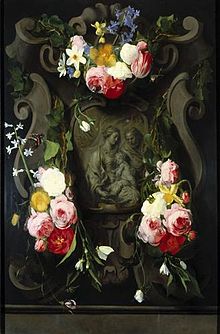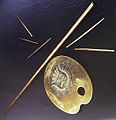- Daniel Seghers
-
 Daniel Seghers from Jan Meyssens's Image de divers Hommes d'espirit sublime (1649), after a lost painting by Jan Lievens. It was published in Het Gulden Cabinet (p 213) in 1662.
Daniel Seghers from Jan Meyssens's Image de divers Hommes d'espirit sublime (1649), after a lost painting by Jan Lievens. It was published in Het Gulden Cabinet (p 213) in 1662.
Daniel Seghers (3 December 1590 – 2 November 1661) was a Jesuit brother and Flemish Baroque painter who specialized in flower still lifes, and is particularly well-known for his contributions to the genre of "flower garland" painting.[1] His paintings were collected enthusiastically by courtly patrons and he had numerous imitators.[2] He was the elder brother of the painter Gerard Seghers.
Contents
Biography
Born in Antwerp, Seghers moved to the Dutch Republic around 1601, following the death of his father Pierre and the conversion of his mother to Calvinism.[1] The young artist returned to Antwerp by 1611, where he was enrolled in the guild of St. Luke as a student of Jan Brueghel the Elder.[1] After re-converting back to Catholicism, in 1614 he became a noviciate in the Jesuit order in Mechelen.[2] Until 1625 Seghers continued to work as a painter in Antwerp, as well as a stay in Brussels in 1621.[2] Sources differ regarding his status in the Jesuit order: some claim that he was ordained a priest in 1625,[1] while other argue that he remained a lay brother.[2] Between 1625 to 1627, the artist was in Italy, and from 1627 until his death in 1661, Seghers remained mostly in Antwerp.[1]
Work
Flower garland paintings
Seghers's work reflects a distinctively Flemish genre in which a garland of flowers surrounds an image of the madonna, a saint and other religious symbols.[3] This type of picture had been invented by Seghers's teacher Jan Brueghel and Federico Borromeo at the beginning of the seventeenth century, and was initially connected to the visual imagery of the Counter-Reformation movement.[3] Seghers distinguished himself from his teacher by including cartouches as framing elements.[1] By the second half of the century, however, secular themes such as portraits and mythological subjects also decorated the central part of the many paintings made in this fashion.[2].
Collaboration
Seghers himself generally only painted the flowers—frequently locally-grown roses and tulips that are just about to bloom—and the central subject was filled in later by another artist.[1][2] This spirit of artistic collaboration, which was seen in the earliest flower garland paintings by Brughel and Peter Paul Rubens, is, in fact, a notable quality of Flemish painting in seventeenth-century Antwerp.[4] Although many of Seghers collaborators were anonymous local artists, he often worked with Cornelis Schut (44x), Erasmus Quellinus II (28x), Abraham van Diepenbeek (6x), Simon de Vos (6x), Jan van den Hoecke (2x), Gonzales Coques (2x) and Rubens (2x).[1][2] Thomas Willeboirts Bosschaert is mentioned as his assistant.[5] In a process counter to his later works, Seghers appears to have added flower garlands to existing paintings by Domenichino during his time in Rome.[6]
Reception
Daniel Seghers's art was widely admired during his lifetime, generating great interest from collectors and spawning imitators such as Jan Philips van Thielen.[2] His paintings were highly prized and collected at the court of Frederik Hendrik in the Hague.[2] There, the art collector and secretary to the prince Constantijn Huygens praised the paintings in poetry and corresponded numerous times with the artist,[2] writing that one could almost smell the flowers.[7] The Dutch poet Joost van den Vondel also wrote highly of Seghers's paintings.[2] Other collectors include Christina of Sweden, Charles I, Philip IV of Spain, Maria de' Medici and Charles II, who visited the artist in 1649, and Archduke Leopold Wilhelm of Austria.[1][2]
Many of Seghers's paintings are oil on copper, a support often used for cabinet paintings. In fact, his paintings were not sold through traditional contacts such as art dealers, but were instead presented as gifts by the Jesuit order to those, including members of the nobility, who were providing funds for the running of their schools.
-
Daniel Seghers Garland with Virgin 1645 paid with gold maulstick.[7]
-
Copy of Daniel Seghers golden maulstick payment 1646 (Rubens House).
References
- ^ a b c d e f g h i Irene Haberland, "Seghers, Daniel," Grove Art Online. Oxford University Press, [accessed 25 May 2008].
- ^ a b c d e f g h i j k l John Rupert Martin, "A Portrait of Rubens by Daniel Seghers," Record of the Art Museum, Princeton University, vol. 17 (1958), pp. 2-20.
- ^ a b David Freedberg, "The Origins and Rise of the Flemish Madonnas in Flower Garlands, Decoration and Devotion", Münchener Jahrbuch der bildenden Kunst, xxxii, 1981, pp. 115–150.
- ^ Anne T. Woollett, Ariane van Suchtelen, et al., Rubens & Brueghel: A Working Friendship, Los Angeles: J. Paul Getty Museum, 2006. ISBN 9780892368471
- ^ Cataloge van de Bloem-stukken, die ik selfs met mijn hand heb geschildert en voor wie. «Cateloque of flower-still lifes, which I have painted and for whom»
- ^ Richard E. Spear, "Domenichino Addenda," The Burlington Magazine, vol. 131 (Jan. 1989), p. 15, n. 67.
- ^ a b Huygens praise of Seghers's painted flowers (in Latin), IN PRAESTANTISSIMI PICTORIS DAN. SEGHERI ROSAS.
External links
Categories:- 1590 births
- 1661 deaths
- Belgian Jesuits
- Flemish Baroque painters
- Members of the Antwerp Guild of Saint Luke
-
Wikimedia Foundation. 2010.



